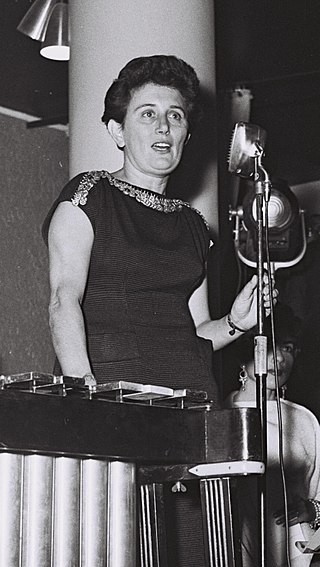
Moshe Dayan was an Israeli military leader and politician. As commander of the Jerusalem front in the 1948 Arab–Israeli War, Chief of Staff of the Israel Defense Forces (1953–1958) during the 1956 Sinai War, and especially as Defense Minister during the Six-Day War in 1967, he became a worldwide fighting symbol of the new state of Israel.

Yael Dayan, also known as Yaël Dayan, was an Israeli politician and author. She served as a member of the Knesset between 1992 and 2003, and from 2008 to 2013 was the chair of Tel Aviv city council. Her service on the city council ended with the 2013 election. She was the daughter of Moshe Dayan and the sister of Assi and Udi Dayan.

Nahalal is a moshav in northern Israel. Covering 8.5 square kilometers (3.3 sq mi), it falls under the jurisdiction of the Jezreel Valley Regional Council. In 2022 it had a population of 1,351.

Shmuel Dayan was a Zionist activist during the British Mandate of Palestine and an Israeli politician who served in the first three Knessets.

Uri Ilan was an Israeli soldier taken hostage by the Syrians during the Zarzar operation on the Golan Heights and committed suicide in Syrian captivity, after being captured in a covert operation. He became a symbol of courage and patriotism in Israel.
Nissan Rilov was an Israeli artist. Prior to undertaking his artistic career, he served in paramilitary and military groups such as the Special Night Squads (SNS), the Haganah, and the British Army during World War II. Rilov became disenchanted with Zionism after a series of experiences that culminated in his refusal to obey an order to shoot an elderly man and his expulsion from the Haganah. He went on to study painting in Israel before emigrating to Paris, where he created art, founded an arts centre, and was active in supporting the Palestinian struggle for independence.

Dov Yermiya was an Israeli military officer and political activist who became notable for severely criticizing Israeli military actions.

Dalton is a moshav near Safed in northern Israel under the jurisdiction of Merom HaGalil Regional Council. It was founded by immigrants from Tripoli in Libya in 1950 under the leadership of Hapoel HaMizrachi.

Kfar Vitkin is a moshav in central Israel. Located near Netanya, it falls under the jurisdiction of Hefer Valley Regional Council and was the first Jewish settlement in the valley. In 2022 it had a population of 2,002.

Kfar Yehoshua is a moshav in northern Israel. Located between Haifa and Nazareth, it falls under the jurisdiction of Jezreel Valley Regional Council. In 2022 it had a population of 1,251.

Ruth Dayan was an Israeli social activist who was the founder of the Maskit fashion house. She was also the first wife of Israeli Foreign Minister and General, Moshe Dayan (1915–1981). Active in many social causes, Dayan was a recipient of the Israeli President's Medal of Distinction, the Solomon Bublick Award, and the Yigal Allon Prize, in recognition of her social empowerment efforts.

Amos Hadar was an Israeli politician who served as a member of the Knesset for the Alignment between 1974 and 1981.

An Israeli Love Story is a play translated from the Hebrew play Sippur Ahava Eretz Yisraeli. It premiered in 2008 and still runs in repertory at Tel Aviv's Givatayim Theater and Cameri Theater.
Events in the year 1956 in Israel.
Events in the year 1955 in Israel.

Sanhedria Cemetery is a 27-dunam (6.67-acre) Jewish burial ground in the Sanhedria neighborhood of Jerusalem, adjacent to the intersection of Levi Eshkol Boulevard, Shmuel HaNavi Street, and Bar-Ilan Street. Unlike the Mount of Olives and Har HaMenuchot cemeteries that are located on the outer edges of the city, Sanhedria Cemetery is situated in the heart of western Jerusalem, in proximity to residential housing. It is operated under the jurisdiction of the Kehilat Yerushalayim chevra kadisha and accepts Jews from all religious communities. As of the 2000s, the cemetery is nearly filled to capacity.

The Shaare Zedek Cemetery is a small Jewish burial ground located behind the first Shaare Zedek Hospital in Jerusalem. Originally used by the hospital as farmland for grazing milk cows, the area was converted into a temporary cemetery during the Arab siege of Jerusalem in 1948. Approximately 200 burials were conducted here between March and October of that year. Most graves were transferred to permanent cemeteries after the war, but a handful remain, notably those of several prominent Jerusalem rabbis and the founding director of Shaare Zedek Hospital, Dr. Moshe Wallach.

Asaf Simhoni was a major general in the IDF, served as head of Northern Command, Assistant Head of Operations Directorate, and later as the Head of Southern Command. Simhoni headed Israel's main effort during the Suez Crisis. He died on the night the war ended in a plane crash on the way to Haifa.

Moshe "Muki" Betser is a retired Israel Defense Forces colonel who served from 1964 to 1986. Considered "one of Israel’s legendary commandoes", while Betser was deputy commander of Sayeret Matkal he helped plan and was the commander of the break-in teams during Israel's Operation Entebbe. He was also involved in the 1973 Israeli raid on Lebanon and the failed hostage rescue operation during the Ma'alot massacre.





















